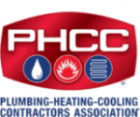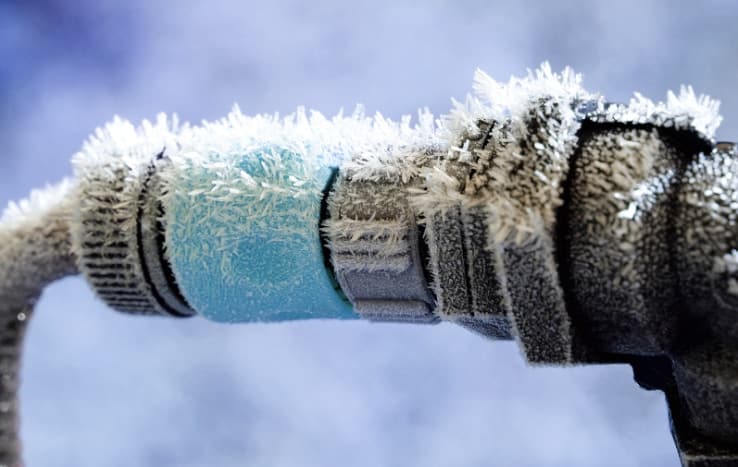Frozen Pipes
Less Mess. Less Stress.
Frozen Pipe Repair in Frisco and DFW
As a homeowner, you’re always on guard against the usual suspects – leaks, clogs, and the occasional drippy faucet.
But there’s a silent threat lurking in the shadows, especially during the colder months: Frozen Pipes. These unassuming parts of your home’s plumbing system can cause havoc when temperatures plummet.
In this comprehensive guide, we’ll dive deep into everything you need to know about frozen pipes, from prevention to repair.
The Guide to Frozen Pipes in Dallas and the Surrounding Areas
The Science Behind Iced Pipes
When the water inside your plumbing system encounters freezing temperatures, it begins to freeze. This phenomenon is particularly prevalent in colder regions, including Denton, TX, Irving, TX, Carrollton, TX, and Richardson, TX.
The process starts when the temperature of the water drops below 32°F (0°C), the freezing point for water.
As the water freezes, it expands, creating immense pressure within the pipes. This pressure is often too much for the pipe material, whether it’s metal or plastic, leading to cracks or even bursts.
Understanding the science behind frozen pipes is crucial for homeowners. It’s not just about the water turning into ice; it’s about the physical changes that occur within your plumbing system.
The expansion of ice against the walls of the pipes can cause microfractures, which may not be immediately visible. Over time, these can worsen, leading to significant leaks and bursts.
The Impact of Frozen Pipes on Your Home
The consequences of iced pipes extend far beyond a temporary inconvenience. When a pipe bursts, it can unleash a torrent of water into your home, leading to extensive water damage. This damage can affect your home’s structural integrity, ruin furniture, and create an ideal environment for mold growth.
In areas like Denton, TX, and surrounding cities, where temperatures can drop suddenly, the risk of pipe freezing is a constant winter concern.
The cost of repairs from a single burst pipe can run into thousands of dollars, not to mention the potential loss of irreplaceable personal items and the disruption to your daily life.
Furthermore, water damage can lead to long-term issues in your home, such as weakened structural elements and health risks from mold and mildew.
Geographical Susceptibility to Frozen Pipes
Certain areas are more prone to the issue of frozen pipes. In Texas, cities like Denton, Frisco, Carrollton, and Richardson experience varying winter temperatures, with occasional dips into freezing conditions.
These fluctuations can catch homeowners off guard, as pipes that are not adequately insulated or heated can quickly freeze.
The geographical location of your home plays a significant role in the likelihood of experiencing frozen pipes.
Homes in these Texas cities often have pipes that run through unheated or poorly insulated areas like basements, attics, and garages. These pipes are at a higher risk of freezing due to their exposure to cold air.
Understanding your home’s specific vulnerabilities based on its location and construction is key to preventing frozen pipes.
Preventive Measures for Homeowners
Preventing iced pipes is far more cost-effective than dealing with the aftermath of a burst pipe.
Homeowners in susceptible areas like Denton, TX, and neighboring cities should take proactive steps to protect their plumbing systems. This includes insulating pipes, especially those in unheated areas, and keeping the house warm during cold snaps.
Another effective preventive measure is to let faucets drip slightly during extremely cold weather. This keeps water moving through the pipes, reducing the chance of it freezing.
Additionally, sealing any drafts in your home, particularly in areas where pipes are located, can significantly reduce the risk.
Homeowners should also be aware of the location of their main water shut-off valve, as this can be crucial in minimizing damage if a pipe does burst.
The Role of Professional Plumbers in Managing Frozen Pipes
While homeowners can take many steps to prevent iced pipes, the expertise of professional plumbers is invaluable, especially in high-risk areas.
Plumbers can provide services such as thorough inspections of your plumbing system, identifying areas at risk of freezing, and recommending specific insulation and protective measures.
In the event of iced pipes, professional plumbers have the tools and experience to safely thaw the pipes without causing damage.
They can also repair any damage that has occurred and offer advice on how to prevent future incidents. For residents in Denton, TX, Irving, TX, Carrollton, TX, and Richardson, TX, having a reliable plumber on call during the winter months can be a crucial part of home maintenance.

Photo By AnatolEr at iStock
Why Frozen Pipes are a Serious Concern
The Dangers of Expanding Water in Pipes
The primary concern with iced pipes is the physical property of water to expand when it freezes. This expansion is not a trivial matter; it exerts significant pressure on the confines of a pipe.
This pressure can be immense, often exceeding the strength of the pipe material, whether it’s copper, PVC, or any other commonly used plumbing material.
This expansion and the resulting pressure are the root causes of the most significant danger posed by frozen pipes: the risk of the pipes cracking or bursting.
A crack, even a small one, can lead to a significant leak, while a burst pipe can cause immediate and severe flooding. This is particularly concerning in residential areas, where such an event can lead to substantial damage to the home’s structure and interiors.
The Aftermath of Burst Pipes: Flooding and Water Damage
When a frozen pipe bursts, the immediate consequence is often flooding. This flooding can range from a slow leak that gradually causes damage over time, to a sudden burst that results in immediate and severe flooding.
The impact of this water damage can be extensive, affecting not just the area where the pipe is located but potentially multiple levels of a home, depending on the location of the burst pipe.
Water damage from burst iced pipes is not just a matter of physical damage to the home.
It can also lead to secondary issues, such as the growth of mold and mildew, which can have health implications for the inhabitants. Additionally, water damage can ruin personal belongings, some of which may be irreplaceable, like family heirlooms or important documents.
Financial Implications of Frozen Pipe Damage
The financial impact of iced pipes bursting can be substantial. Repairing or replacing burst pipes is just the beginning.
There’s also the cost of repairing the water damage caused by the burst, which can include replacing drywall, flooring, and other structural elements, as well as repairing or replacing damaged furniture and other belongings.
In addition to these direct costs, there can be indirect financial impacts as well. Depending on the extent of the damage, families may need to find temporary accommodation while repairs are made, adding to the financial burden. Insurance may cover some of these costs, but this often depends on the specific policy and the circumstances of the pipe bursting.
The Psychological Impact of Dealing with Frozen Pipes
Beyond the physical and financial impacts, dealing with the aftermath of a burst frozen pipe can be a significant psychological stressor.
The disruption to daily life, the potential loss of personal belongings, and the stress of coordinating repairs can take a toll on homeowners and families.
This psychological impact is often overlooked but can be one of the most challenging aspects of dealing with burst pipes. The sense of security within one’s home can be profoundly affected, and the fear of a recurrence can linger long after the physical repairs have been made.
Prevention: The Key to Avoiding the Dangers of Frozen Pipes
Given the serious consequences of iced pipes, prevention is key.
Homeowners should take proactive steps to protect their plumbing, especially in regions prone to freezing temperatures. This includes insulating pipes, keeping the home at a consistent temperature, and being vigilant during cold snaps.
While it’s impossible to eliminate the risk entirely, understanding the potential dangers and taking steps to mitigate them can significantly reduce the likelihood of experiencing the disastrous consequences of iced pipes.
Homeowners should also familiarize themselves with the signs of frozen pipes and know what steps to take if they suspect their pipes are at risk of freezing.
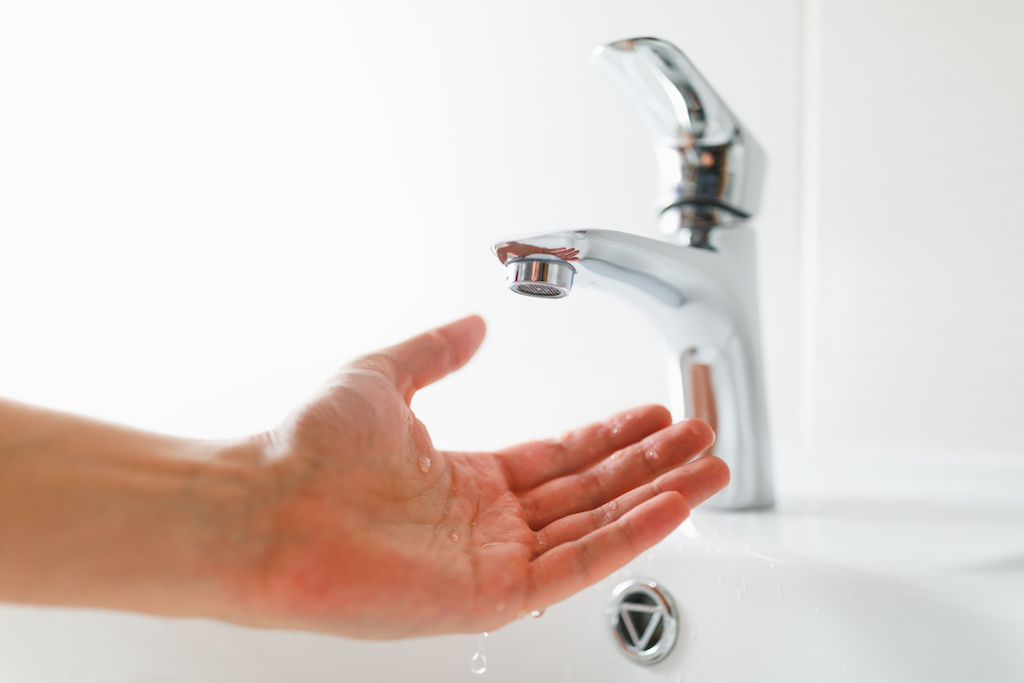
Photo By nikkytok at iStock
Signs Your Pipes Might Be Frozen
The Silent Alarm: No Water Flow from Faucets
One of the most immediate and noticeable signs that you might be dealing with iced pipes is a lack of water flow from your faucets.
Imagine turning on your tap on a chilly morning and finding that no water comes out – this is often the first red flag that your pipes may have frozen overnight.
This absence of water flow occurs because the ice blockage within the pipe prevents water from passing through. It’s a clear indication that somewhere along your plumbing system, water has turned to ice, obstructing the normal flow.
This issue can range from a slight decrease in water pressure to a complete halt in water flow, depending on the severity of the freeze.
A Visible Clue: Frost on the Pipes
Another telltale sign of iced pipes is the presence of frost on the exterior of the pipes. This is often visible in areas where the plumbing is exposed, such as under sinks, in basements, or in crawl spaces.
If you notice a layer of frost on any of your pipes, it’s a strong indicator that the water inside has frozen.
The appearance of frost on the outside of a pipe is a direct result of the freezing process happening within.
As the water inside the pipe freezes and expands, it cools the surrounding material of the pipe, often leading to condensation and frost formation on the outside. This sign is particularly useful for early detection, as it can be observed before any more serious symptoms, like a burst pipe, occur.
Hearing the Problem: Unusual Noises in the Plumbing
Unusual noises coming from your plumbing can also be a sign of iced pipes. These sounds might include clanking, banging, or whistling when you turn on the tap. These noises are caused by the ice within the pipes, which can create turbulence and irregular water flow, leading to strange sounds.
The sounds may vary depending on the extent and location of the freeze within your plumbing system. For instance, a slight whistling might indicate a small ice blockage, while louder banging noises could suggest a more severe freeze.
Paying attention to these auditory clues can help you identify and address iced pipes before they lead to more significant issues.
The Combined Warning Signs
Often, it’s a combination of these signs that will alert you to the problem of iced pipes. No water flow, visible frost, and unusual noises in your plumbing are all indicators that should be taken seriously.
When these signs are observed, especially during cold weather, it’s crucial to act quickly to address the issue.
Recognizing these signs early can make a significant difference in preventing damage. The sooner you identify that you have frozen pipes, the quicker you can take steps to thaw them safely and avoid the potential for them to burst, leading to water damage and costly repairs.
Taking Action: Responding to Signs of Frozen Pipes
Upon noticing any of these signs, it’s important to take immediate action. This might involve attempting to gently thaw the pipes or calling a professional plumber for assistance.
Remember, dealing with iced pipes is time-sensitive; the longer the water remains frozen, the higher the risk of a pipe bursting.
In summary, being vigilant for signs of iced pipes – such as no water flow, visible frost, and unusual noises – is crucial, especially during colder months. Early detection and prompt action can save you from the extensive damage and expenses that can result from burst pipes.
Preventing Frozen Pipes
The Importance of Insulation for Your Pipes
One of the most effective ways to prevent iced pipes is through proper insulation. This is particularly crucial for pipes that are exposed to the exterior of your home or are located in unheated areas like basements, attics, or garages.
Insulating these pipes acts as a barrier against the cold, reducing the likelihood of the water inside them freezing.
Pipe insulation can be done using various materials, such as foam tubing or fiberglass sleeves, which are readily available at most hardware stores.
This insulation not only helps in preventing frozen pipes but also improves energy efficiency in your home by keeping the water in your pipes at a more consistent temperature.
Maintaining a Trickle of Water to Prevent Freezing
Another practical tip to prevent frozen pipes is to keep a slight trickle of water flowing through your faucets during extreme cold spells. This might seem counterintuitive, especially when considering water conservation, but the constant flow of water can prevent freezing within the pipes.
The movement of water, even in small amounts, helps prevent ice from forming inside the pipes. This is particularly important during the night or when temperatures drop to their lowest.
The cost of the extra water used is minimal compared to the potential damage and expense of dealing with a burst pipe.
Sealing Drafts to Protect Your Plumbing
Drafts in your home can introduce cold air to areas where pipes are located, increasing the risk of iced pipes.
Sealing these drafts is a crucial step in preventing this problem. Common areas where drafts occur include around windows, doors, and where utility lines enter the house.
By using weather stripping, caulk, or insulation to seal these drafts, you can significantly reduce the exposure of your pipes to freezing temperatures. This not only helps in preventing frozen pipes but also improves the overall energy efficiency of your home, keeping it warmer during the winter months.
Regular Plumbing Maintenance as a Preventive Measure
Regular maintenance of your plumbing system is also key in preventing iced pipes. This includes having a professional plumber inspect your system, especially before the onset of winter, to identify any potential vulnerabilities.
A plumber can check for pipes that are inadequately insulated or located in areas prone to freezing.
They can also advise on any necessary upgrades or repairs that could reduce the risk of freezing. Regular maintenance ensures that your plumbing system is in good condition to withstand the colder months.
The Role of Home Heating in Preventing Frozen Pipes
Maintaining a consistent temperature in your home is essential in preventing frozen pipes. During cold spells, it’s advisable to keep your heating on, even at a lower temperature, throughout the day and night. This consistent warmth helps to keep the temperature of the pipes above freezing.
For homes with thermostats, setting a consistent temperature can be easily managed. It’s particularly important to maintain heating if you plan to be away from home for an extended period during the winter months.
First Response to Frozen Pipes
Immediate Action: Keeping the Faucet Open
When you suspect that you’re dealing with iced pipes, one of the first and most crucial steps is to keep the affected faucet open. This might seem counterintuitive, but there’s a good reason for it.
By keeping the faucet open, you allow water to flow, which helps to relieve the pressure build-up inside the pipe.
This pressure relief is vital because it’s not the ice expansion alone that causes pipes to burst; it’s the increase in pressure between the blockage and the faucet.
By allowing the faucet to remain open, any melting water can flow out, and this movement can also help to gradually melt the ice blockage. This simple step can be a significant factor in preventing a pipe from bursting.
Applying Gentle Heat to Thaw Frozen Pipes
If you’ve identified where the frozen pipe is located, applying gentle heat to the area can help thaw the ice blockage.
This can be done using a hairdryer, heating pads, or towels soaked in hot water. The key here is to apply the heat slowly and evenly along the pipe, rather than concentrating it on a single spot.
This gradual thawing process is important to avoid causing thermal shock to the pipes, which can lead to cracking.
Never use open flames, such as blow torches or propane heaters, as these can damage the pipes and present a significant fire hazard. The goal is to gently restore the flow of water, not to rapidly heat the pipe.
The Risks of Using Open Flames
One critical piece of advice when dealing with iced pipes is to avoid using open flames. This includes tools like blowtorches, kerosene heaters, or any other flame-based device. The use of open flames is not only ineffective but also incredibly dangerous.
The heat from an open flame can damage the pipe, especially if it’s made of a material like PVC.
Moreover, the risk of causing a fire in your home is significantly increased when using open flames in close proximity to insulation, wooden structures, or other flammable materials. The potential damage from a fire far outweighs the inconvenience of a frozen pipe.
Monitoring and Assessing the Situation
As you apply heat and keep the faucet open, it’s important to monitor the situation closely.
Look for signs of water flow returning to normal and listen for any unusual sounds. If you notice any leaks or water damage, it’s crucial to shut off the main water supply to your home immediately to prevent further damage.
If the situation doesn’t improve or if you’re unable to locate the frozen section, it may be time to call a professional plumber.
They have the tools and expertise to safely thaw frozen pipes and repair any damage that may have occurred.
Preventing Recurrence: Long-Term Solutions
Once you’ve successfully thawed your iced pipes, it’s important to take steps to prevent the issue from recurring.
This might involve adding insulation to your pipes, sealing drafts in your home, or keeping your thermostat at a consistent temperature during cold spells.
Consulting with a professional plumber can also provide insights into why your pipes froze in the first place and what specific measures can be taken to prevent it in the future. Remember, proactive prevention is key to avoiding the stress and damage caused by iced pipes.
Why DIY Can Be Risky
The Complexity of Dealing with Frozen Pipes
Dealing with iced pipes might seem like a straightforward task, but it often involves complexities that go beyond the scope of typical DIY solutions.
While some minor plumbing issues can be effectively handled by homeowners, iced pipes present unique challenges that require a deeper understanding of plumbing systems.
The risk with DIY methods in handling iced pipes lies in the potential for incorrect handling. Without the proper knowledge and tools, attempts to thaw pipes can lead to further damage. For instance, applying too much heat too quickly can cause pipes to crack or burst, leading to significant water damage.
The Risk of Further Damage and Increased Costs
One of the primary risks of attempting to handle iced pipes through DIY methods is causing additional damage. This can happen in several ways, such as improperly thawing pipes, which can lead to cracks or bursts, or failing to identify all the frozen sections, leading to partial solutions that don’t address the entire problem.
When additional damage occurs, it often leads to higher costs in the long run.
What might have been a simple thawing job for a professional can turn into a major repair project, involving replacing sections of pipe, repairing water damage, and possibly dealing with mold issues.
The Importance of Professional Diagnosis and Repair
Professional plumbers bring a level of expertise and experience to the table that is crucial in dealing with iced pipes.
They have the tools and knowledge to diagnose the problem accurately and to determine the safest and most effective way to thaw the pipes without causing damage.
Moreover, professionals can assess the overall condition of your plumbing system and identify any underlying issues that may have contributed to the pipes freezing. This comprehensive approach not only addresses the immediate problem but also helps prevent future occurrences.
Safety Concerns with DIY Approaches
Safety is another important consideration when dealing with iced pipes. DIY methods, especially those involving heat, can pose significant risks. The use of open flames or improper heating devices can lead to fires or personal injury.
Professional plumbers are trained to handle these situations safely, using the appropriate tools and techniques. They also understand the building codes and standards that need to be followed, ensuring that any repairs or modifications are done safely and legally.
The Value of Professional Advice and Long-Term Solutions
In addition to repairing the immediate issue of iced pipes, professional plumbers can provide valuable advice on long-term solutions. This might include recommendations on insulating pipes, rerouting certain sections of plumbing, or upgrading materials to better withstand cold temperatures.
This professional advice can be invaluable in preventing future issues with frozen pipes, ultimately saving homeowners time, money, and stress in the long run.
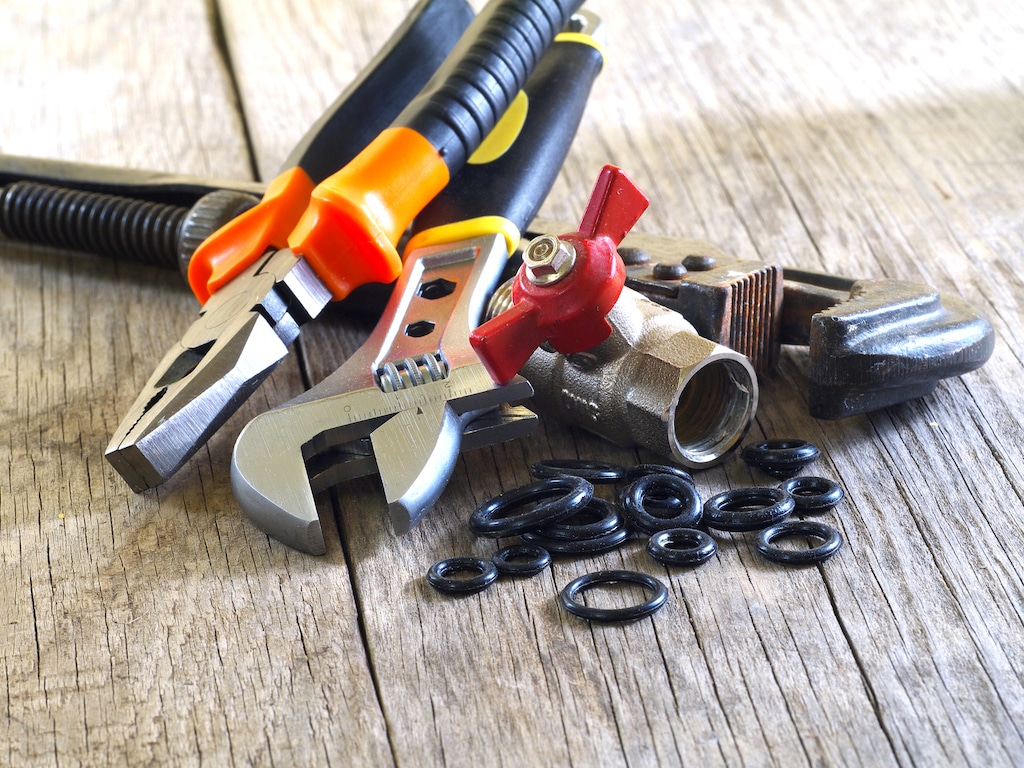
Photo By asadykov at iStock
Our Comprehensive Services
Expert Inspection and Repair for Frozen Pipes
At bluefrog Plumbing + Drain of North Dallas, one of our key services in tackling frozen pipes involves expert inspection and repair. This service is crucial because iced pipes, if not properly addressed, can lead to significant damage to your home’s plumbing system and structure.
Our team of skilled professionals is equipped with the latest tools and technology to conduct thorough inspections of your plumbing system.
We identify areas where pipes are most susceptible to freezing and assess any damage that may have already occurred.
Once we pinpoint the issues, we proceed with precision repairs. This may involve thawing frozen sections, replacing damaged pipes, or making adjustments to prevent future freezing.
Preventative Maintenance to Avoid Frozen Pipes
Preventative maintenance is a critical aspect of our services at bluefrog Plumbing + Drain of North Dallas, especially when it comes to preventing iced pipes.
Regular maintenance is key to ensuring that your plumbing system is prepared to withstand cold temperatures without succumbing to freezing.
Our preventative maintenance service includes inspecting and insulating pipes, especially those in vulnerable areas like basements, attics, and exterior walls. We also check for and seal any leaks or drafts that could expose pipes to cold air.
Additionally, we offer advice on best practices for homeowners to maintain their plumbing during cold weather, such as keeping a consistent indoor temperature and allowing faucets to drip during extreme cold spells.
Emergency Response Services for Frozen Pipes
Understanding the urgent nature of iced pipes, bluefrog Plumbing + Drain of North Dallas offers emergency response services. We are well aware that pipes can freeze and burst at the most inconvenient times, causing immediate and severe damage to your home.
Our emergency response team is on standby to respond quickly to your call, equipped to handle urgent situations effectively.
We prioritize these calls because we understand that time is of the essence in preventing extensive water damage from burst pipes.
Our team works swiftly to address the issue, whether it involves thawing frozen pipes, repairing burst sections, or implementing temporary solutions to mitigate damage while more extensive repairs are planned.
Customized Solutions for Every Home
Recognizing that every home is unique, we at bluefrog Plumbing + Drain of North Dallas provide customized solutions for dealing with iced pipes.
We take into account the specific layout and construction of your home, the local climate conditions, and your particular concerns and needs.
Our approach is not one-size-fits-all; we tailor our services to ensure the most effective and efficient resolution for your specific situation.
Whether it’s a historic home with old pipes or a modern residence with the latest plumbing technology, we have the expertise to provide the best solutions for preventing and repairing frozen pipes.
Long-Term Partnership for Plumbing Health
Our relationship with our clients doesn’t end with a single service call.
We view each interaction as the beginning of a long-term partnership in maintaining the health of your plumbing system. This includes follow-up services, ongoing maintenance advice, and support for any future plumbing needs.
Our goal is to ensure that your home is protected from the risks of iced pipes not just for one winter, but for many years to come. We strive to be your trusted plumbing service provider, offering reliable, high-quality services whenever you need them.
At Bluefrog Plumbing + Drain of North Dallas, our comprehensive services for iced pipes include expert inspection and repair, preventative maintenance, emergency response, customized solutions, and a commitment to long-term partnerships with our clients.
We are dedicated to providing the best possible service to ensure your home’s plumbing system is robust and reliable, especially during the cold months when the risk of frozen pipes is highest.
Service Locations for Frozen Pipes Solutions
Denton, TX: Battling Frozen Pipes in a Dynamic Climate
In Denton, TX, residents often face the challenge of frozen pipes due to the area’s dynamic climate, where temperatures can drop sharply in winter.
Our team is well-versed in the specific plumbing needs of Denton homes, understanding how local weather patterns can affect your pipes.
We provide tailored solutions to prevent and address frozen pipes, ensuring that your home’s plumbing system remains functional and safe during the cold months.
Irving, TX: Expert Frozen Pipes Services
Irving, TX, is another area where homeowners frequently encounter issues with frozen pipes. Our services in Irving are designed to tackle these challenges head-on.
We offer comprehensive inspections and repairs, ensuring that your plumbing is well-prepared to withstand the colder temperatures.
Our team’s expertise in the Irving area means we can quickly identify and resolve any frozen pipe issues, minimizing the risk of damage to your property.
Carrollton, TX: Proactive Approach to Frozen Pipes
In Carrollton, TX, the risk of frozen pipes is a significant concern for many homeowners. Our approach in Carrollton focuses on proactive measures, helping residents to prepare their plumbing systems before the winter sets in.
From insulating pipes to offering maintenance tips, we ensure that your home in Carrollton is equipped to handle the challenges of freezing temperatures, reducing the likelihood of iced pipes.
Richardson, TX: Reliable Frozen Pipes Solutions
Lastly, in Richardson, TX, our team provides reliable solutions for iced pipes.
Understanding the specific needs of Richardson homes, we offer both emergency response services and long-term preventative strategies.
Whether you’re dealing with an immediate frozen pipe issue or looking to safeguard your plumbing for the future, our services in Richardson are designed to offer peace of mind and effective results.
What Our Clients Are Saying
At bluefrog Plumbing + Drain of North Dallas, our commitment to quality service is reflected in the glowing reviews from our clients.
With an impressive 4.9-star rating from 423 reviews, our customers’ satisfaction speaks volumes about our dedication to excellence in plumbing services.
One of our clients, Christine Lui, recently shared her experience with our team. When her parents’ tankless water heater failed, she turned to us for maintenance of her own system.
Despite an initial misquote, our team, led by Martin, provided exceptional service, ensuring all her questions were answered and her water heater was thoroughly inspected. Christine’s review highlights our commitment to customer satisfaction and our swift response to any concerns.
Another client, Martin Casey, praised our team for the excellent job done in replacing all the sewer pipes in his home.
He appreciated the clear communication and the professional approach of our team, particularly Jacob, who kept him informed throughout the process. This review underscores our ability to handle complex plumbing tasks with efficiency and transparency.
Denise Cox, another satisfied customer, commended Jeremy from our team for his punctuality, positive energy, and honesty.
She was impressed with his quick and efficient service in replacing a shower cartridge and trim kit, and pleasantly surprised that the cost came in under other estimates.
These testimonials are a testament to our unwavering commitment to providing top-notch plumbing services.
Whether it’s routine maintenance, emergency repairs, or complex installations, our team at bluefrog Plumbing + Drain of North Dallas is dedicated to delivering exceptional service and ensuring the utmost satisfaction of our clients.
Explore more about our services and read additional client testimonials on our Google page.
Ready to Tackle Your Frozen Pipes? Contact Us Now!
Are you facing the challenge of frozen pipes in your home? Don’t let this issue turn into a costly disaster. At bluefrog Plumbing + Drain of North Dallas, we’re here to provide you with expert solutions and peace of mind.
Whether you need immediate assistance or want to prepare for the colder months, our team is ready to help.
With our comprehensive services, including inspections, repairs, and preventative maintenance, we ensure that your plumbing system is in top condition to withstand freezing temperatures.
Don’t wait for a small problem to become a major headache. Call us now at 469-573-2535 for prompt, professional, and reliable service. Trust bluefrog Plumbing + Drain of North Dallas to keep your home safe and dry, no matter the weather.
Call 469-573-2535 – Your Solution to Frozen Pipes is Just a Phone Call Away!

Photo By Nika Ray at iStock
FAQs
- What causes pipes to freeze?
Pipes freeze when the water inside them is exposed to temperatures below freezing, causing the water to turn into ice. This is more likely to occur in pipes that are poorly insulated or located in unheated areas of a home.
- How can I tell if my pipes are frozen?
Signs of frozen pipes include reduced or no water flow from faucets, visible frost on exposed pipes, and strange noises like clanking or whistling when the water is turned on.
- What should I do if I suspect my pipes are frozen?
If you suspect frozen pipes, keep the affected faucet open to relieve pressure, and apply gentle heat to the frozen section using a hairdryer or towels soaked in hot water. Avoid using open flames.
- Can frozen pipes burst?
Yes, frozen pipes can burst. When water freezes, it expands, creating pressure inside the pipe. If the pressure becomes too great, it can cause the pipe to crack or burst.
- What are the risks of trying to thaw frozen pipes myself?
DIY attempts to thaw frozen pipes can lead to further damage if not done correctly. Applying too much heat too quickly can crack the pipes, and using open flames can be dangerous.
- How can I prevent my pipes from freezing?
To prevent frozen pipes, insulate your pipes, especially those in unheated areas, keep your home at a consistent temperature, and allow faucets to drip slightly during extremely cold weather to keep water moving.
- Should I call a professional for frozen pipes?
Yes, it’s often best to call a professional, especially if you are unable to locate the frozen section, or if the situation doesn’t improve with initial efforts. Professionals have the right tools and expertise to handle the issue safely.
- What services does bluefrog Plumbing + Drain of North Dallas offer for frozen pipes?
We offer expert inspection and repair, preventative maintenance, and emergency response services for frozen pipes.
- Are there any long-term solutions to prevent frozen pipes?
Long-term solutions include upgrading insulation, sealing drafts in your home, and possibly rerouting pipes to less vulnerable areas. Regular maintenance checks by a professional can also help.
- How quickly can bluefrog Plumbing + Drain of North Dallas respond to a frozen pipe emergency?
We offer emergency response services and strive to respond as quickly as possible to minimize damage and restore your plumbing system’s functionality.
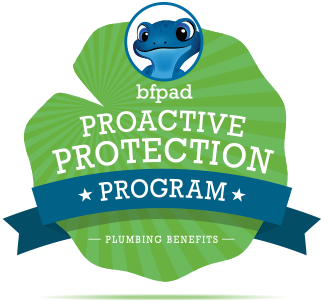
bfpad Proactive Protection ProgramTM
Many of our customers are so happy with our service that they become a bfpad Proactive Protection Program™! Contact us to learn more.
 Priority Service
Priority Service Free Annual Plumbing Evaluation
Free Annual Plumbing Evaluation 15% OFF Service
15% OFF Service

Service Area





